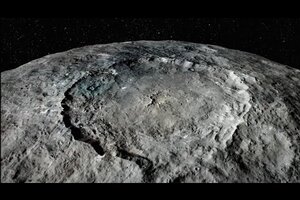What is it like to orbit Ceres? This NASA animation will show you.
NASA's latest video allows earthbound viewers to travel vicariously to our solar system's asteroid belt with the Dawn spacecraft.

Take a flight over dwarf planet Ceres in this video made with images from NASA's Dawn spacecraft. The simulated flyover was made by the mission's camera team at Germany's national aeronautics and space research center (DLR).
Astronomy buffs now have a chance to see what it’s like to orbit a distant world, thanks to a new animation released by NASA.
NASA’s latest video depicts the dwarf planet Ceres, as seen by the Dawn spacecraft. The video shows many of Ceres’ topographical features, including its great crater Occator and the mountain Ahuna Mons, as well as its now famous “bright spots.”
"The simulated overflight shows the wide range of crater shapes that we have encountered on Ceres,” German mission scientist Ralf Jaumann said in a blog post form NASA’s Jet Propulsion Laboratory. “The viewer can observe the sheer walls of the crater Occator, and also Dantu and Yalode, where the craters are a lot flatter."
Dawn has been orbiting Ceres since March, when it became the first mission to orbit a dwarf planet.
Like the more widely known dwarf planet Pluto, Ceres hasn’t always been categorized as such. When astronomer Giuseppe Piazzi discovered Ceres on the first night of 1801, he thought he had discovered a comet. By mid 1801, most astronomers were fairly sure it was a planet instead of a comet. Because it was so small, however, they eventually settled on classifying it as an asteroid.
It wasn’t until 2006 that Ceres received an upgrade in status and became known as a dwarf planet. (Incidentally, that was the same year astronomers demoted Pluto from a planet to a dwarf planet.)
One year later, NASA launched its Dawn spacecraft on a mission to capture images of far away Ceres and its neighbor, the asteroid Vesta. Dawn entered Ceres’ orbit in March, 2015.
“”When Piazzi discovered Ceres, exploring it was beyond imagination.” Dawn mission director Mark Rayman said in the JPL post. “More than two centuries later, NASA dispatched a machine on a cosmic journey of more than 3 billion miles to reach the distant, mysterious world he glimpsed."
As Dawn orbits the dwarf planet, it has collected images that help scientists understand Ceres’ composition and topology.
One of Dawn’s most intriguing discoveries has been the appearance of several bright spots on the floors of Ceres’s craters. Initially, scientists speculated that the brightness might be caused by icy or salty material. After further observation, scientists believe that the bright areas, tinted blue in the video, are areas of newer material such as flows, pits, and cracks in the dwarf’s surface.
Scientists hope data gathered during Dawn’s orbit of Ceres, as well as it’s prior 14-month stint orbiting the protoplanet Vesta, will offer insight into the way the universe was formed, Carol Raymond, planetary scientist at NASA’s Jet Propulsion Laboratory, told The Monitor in March.
"They are two fossils we can investigate to understand what was really going on at that time," she told Mr. Spotts.
[Editor's note: An earlier version of the summary misstated the location of the asteroid belt.]

